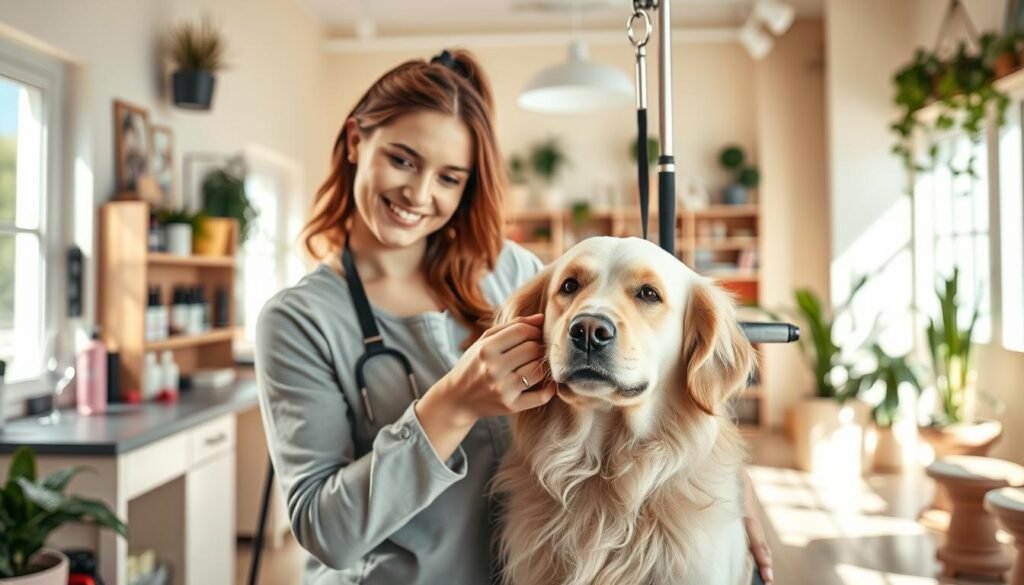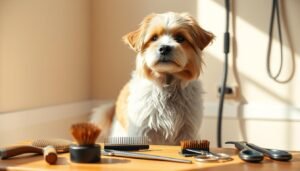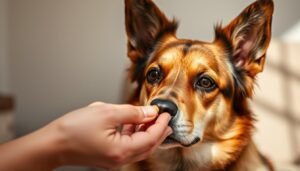A clean companion animal is a healthy one. Regular Dog Grooming is not just about appearance; it’s crucial for preventing health issues and strengthening the bond between you and your furry friend.
Did you know that neglecting Pet Grooming can lead to serious health problems, including skin infections and matting that can cause pain and discomfort? Regular grooming sessions can help identify potential issues early on, ensuring your pet stays healthy and happy.
Key Takeaways
- Regular grooming prevents health issues in pets.
- Grooming strengthens the bond between pets and owners.
- Early detection of health problems is possible through regular grooming.
- Pet Grooming Services can provide professional care for your pet.
- A well-groomed pet is a happy and healthy pet.
Understanding Pet Grooming
Pet grooming is an essential aspect of pet care that contributes significantly to the overall health and well-being of your pet. Proper grooming is crucial not only for your pet’s health but also for your own health and lifestyle.
What is Pet Grooming?
Pet grooming encompasses a variety of activities aimed at maintaining your pet’s hygiene, comfort, and overall health. It includes tasks such as brushing their coat, trimming their nails, cleaning their ears, and bathing them. Regular grooming sessions provide an opportunity to inspect your pet’s body for any signs of illness or injury.
Importance of Grooming for Pets
Grooming is vital for pets as it helps in the early detection of health issues. For instance, during grooming, you can check for skin irritations, infections, or parasites like fleas and ticks. Moreover, grooming helps in distributing skin oils, preventing matting and tangling of fur, and reducing shedding. It’s also a great way to strengthen the bond between you and your pet, promoting a sense of trust and comfort.
Benefits of Regular Grooming
The benefits of regular grooming are numerous. It not only keeps your pet looking their best but also contributes to their overall health. Regular grooming can help prevent health issues such as matting, which can cause skin irritation, and overgrown nails, which can lead to discomfort or injury. Furthermore, grooming sessions provide a chance to check for any abnormalities, ensuring your pet receives timely medical attention if needed.
By incorporating professional pet grooming practices into your pet care routine, you can ensure your pet enjoys the best possible care. Whether you choose to groom your pet at home or visit a professional groomer, the key is consistency and attention to detail.
Essential Grooming Tools for Pet Owners
Having the essential grooming tools is crucial for maintaining your pet’s health and appearance. Whether you’re grooming a dog or a cat, the right equipment can make all the difference in keeping them clean and comfortable.
Brushes and Combs
Brushes and combs are fundamental tools for Dog Grooming and Cat Grooming. The type of brush or comb you need depends on your pet’s fur type. For instance, a slicker brush is ideal for removing tangles and mats from long-haired breeds, while a bristle brush is better suited for short-haired dogs. For cats, a gentle comb can help reduce shedding and prevent hairballs.
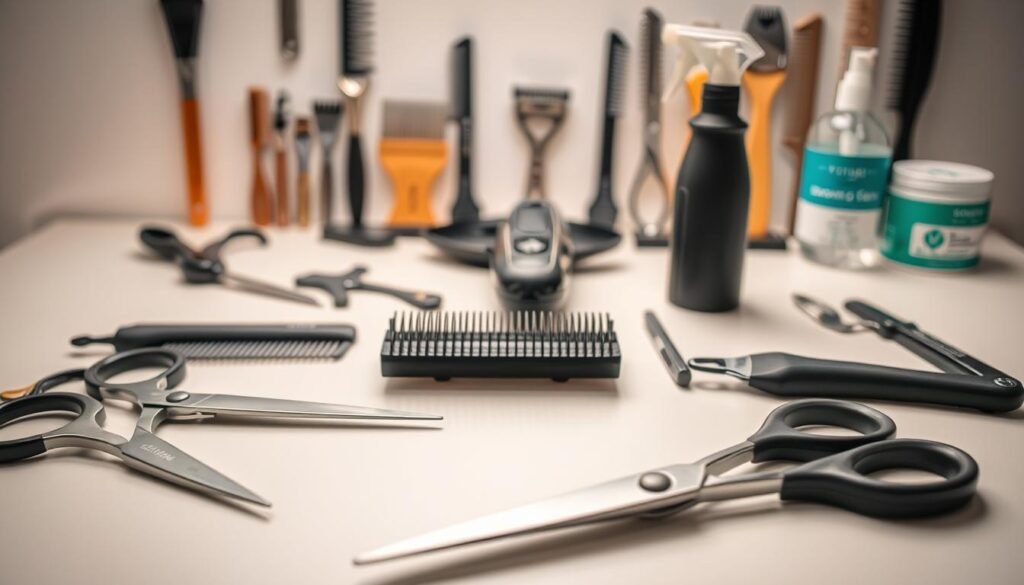
Nail Clippers
Nail clippers are another essential tool for pet grooming. Keeping your pet’s nails trimmed is important for their comfort and health. For Affordable Pet Grooming, it’s crucial to choose nail clippers that are appropriate for your pet’s size and nail type. There are different types of clippers for dogs and cats, so be sure to select the right one.
Grooming Scissors
Grooming scissors are used for trimming fur and can be especially useful for pets with long hair. It’s essential to use scissors specifically designed for pet grooming to avoid accidents. When using grooming scissors, it’s a good idea to be cautious and gentle to ensure a safe and effective grooming experience.
Bathing Supplies
Bathing is a critical aspect of pet grooming. You’ll need a suitable shampoo and conditioner for your pet’s coat type. For dogs and cats with sensitive skin, look for hypoallergenic products. Bathing supplies should also include a towel or dryer for drying your pet after the bath. Regular bathing is part of Dog Grooming and Cat Grooming routines, helping to keep their coats clean and healthy.
How Often Should You Groom Your Pet?
Grooming frequency is a common query among pet owners, and the answer lies in understanding your pet’s specific needs. The frequency of grooming depends on various factors, including the pet’s breed, coat type, and individual requirements.
Factors Influencing Grooming Frequency
Several factors determine how often you should groom your pet. These include:
- Breed: Different breeds have different grooming needs. For example, long-haired breeds require more frequent grooming than short-haired ones.
- Coat Type: Pets with thick or curly coats need more regular grooming to prevent matting and tangling.
- Age and Health: Senior pets or those with certain health conditions may require adjusted grooming frequencies.
- Lifestyle: Pets that spend a lot of time outdoors may need more frequent grooming due to dirt and debris accumulation.
Breeds that Require More Grooming
Some pet breeds are known to require more grooming than others. These include:
- Long-Haired Breeds: Breeds like the Afghan Hound and the Maltese need daily brushing to prevent matting.
- Curly-Coated Breeds: Dogs like Poodles and Bichon Frise require regular grooming to prevent their coats from matting.
- Thick-Coated Breeds: Breeds such as the Siberian Husky and the Newfoundland need regular brushing to manage their thick coats.
Seasonal Considerations
Seasonal changes can also impact how often you should groom your pet. For instance:
- Summer: More frequent grooming may be necessary to help keep your pet cool and to remove loose hair.
- Winter: Less frequent bathing might be appropriate, but regular brushing is still necessary to prevent matting.
By considering these factors and adjusting your grooming routine accordingly, you can ensure your pet remains healthy and comfortable throughout the year. For pet owners looking for convenience, mobile pet grooming services can be a great option, bringing professional grooming right to your doorstep.
DIY Grooming: Tips and Techniques
With a little practice and patience, you can master the art of DIY grooming for your furry friend. Grooming your pet at home not only strengthens your bond but also helps in early detection of any health issues.
Bathing Your Pet at Home
Bathing is an essential part of pet grooming. To bathe your dog at home, start by brushing their hair thoroughly to prevent matting. Then, place them in a tub filled with lukewarm water, ensuring it’s not too hot or cold. Use a gentle dog shampoo, and be sure to rinse all soap out of their coat.
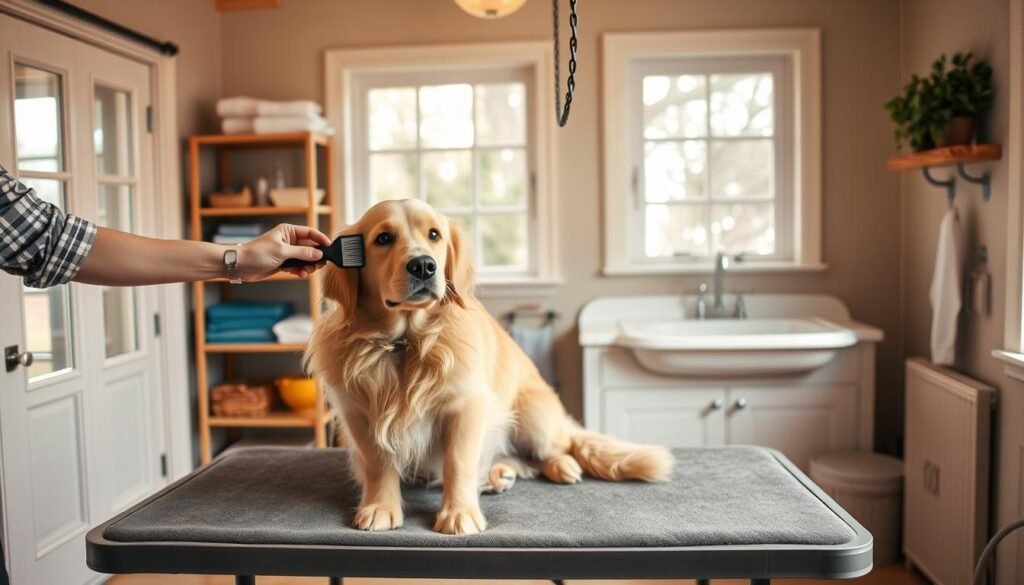
Brushing Techniques for Different Fur Types
Brushing is crucial for maintaining your pet’s coat. For short-haired dogs, a rubber brush or a bristle brush works well. For long-haired breeds, use a slicker brush or a pin brush to detangle and prevent matting. Regular brushing reduces shedding and distributes skin oils for a healthy coat.
Nail Trimming Done Right
Nail trimming is a critical aspect of pet grooming. To trim your pet’s nails safely, use a pair of dog nail clippers. For light-colored nails, you can see the quick (the pink part of the nail), so trim just before it. For dark nails, trim a little at a time to avoid cutting the quick.
| Grooming Task | Frequency | Tips |
|---|---|---|
| Bathing | Monthly | Use lukewarm water and gentle shampoo. |
| Brushing | Daily/Weekly | Choose the right brush for your pet’s fur type. |
| Nail Trimming | Every 4-6 weeks | Be cautious not to cut the quick. |
By following these DIY grooming tips, you can keep your pet clean, healthy, and happy. Regular grooming not only improves your pet’s appearance but also enhances their overall well-being.
Professional Pet Grooming Services
Professional pet grooming services offer a level of expertise and convenience that can be hard to replicate at home. While many pet owners successfully groom their pets themselves, there are instances where the specialized care and attention provided by a professional groomer are invaluable.
Benefits of Hiring a Professional Groomer
Hiring a professional groomer comes with several benefits. These include:
- Expertise: Professional groomers are trained to handle pets of various breeds and temperaments, ensuring your pet receives the best care possible.
- Convenience: With mobile pet grooming services becoming increasingly popular, you can have your pet groomed in the comfort of your own home.
- Specialized Care: Professional groomers can identify potential health issues early on, such as skin irritations or ear infections, and advise on appropriate care.
How to Choose the Right Groomer
Choosing the right groomer for your pet involves several considerations:
- Look for groomers with good reputations and reviews from other pet owners.
- Check if the groomer has experience with your pet’s breed or type.
- Ensure the groomer uses clean, safe equipment and practices good hygiene.
What to Expect from a Grooming Appointment
During a grooming appointment, you can expect the groomer to:
- Assess your pet’s condition and discuss any specific needs or concerns.
- Perform the necessary grooming tasks, such as bathing, trimming, and nail clipping.
- Provide advice on how to care for your pet between grooming sessions.
By understanding what professional pet grooming services offer, you can make an informed decision about whether to use these services for your pet. Whether you’re looking for “pet grooming near me” or considering the convenience of mobile pet grooming, there’s a service to suit your needs.
Breed-Specific Grooming Needs
Understanding the grooming needs of your pet based on its breed is crucial for its health and appearance. Different breeds have distinct coat types and requirements that necessitate tailored grooming approaches.
Grooming Long-Haired Breeds
Long-haired breeds, such as the Afghan Hound and the Persian cat, require regular grooming to prevent matting and tangling. Daily brushing is essential to keep their coats clean and healthy. Using the right brush, such as a slicker brush or a pin brush, can make a significant difference in managing their long hair.
Regular grooming sessions also provide an opportunity to inspect for skin issues or parasites. For long-haired dogs, it’s advisable to bathe them every 4-6 weeks, or as needed, to keep their coats clean without stripping them of their natural oils.
Caring for Short-Haired Dogs
Short-haired dogs, like the Beagle or the Boxer, have different grooming needs compared to their long-haired counterparts. While they may not require daily brushing, regular grooming is still necessary to remove dead hair and distribute skin oils. A rubber grooming mitt or a soft-bristle brush can be effective tools for short-haired breeds.
Bathing frequency for short-haired dogs can vary, but generally, they need a bath every 2-3 months, unless they get dirty or develop a strong body odor. It’s also important to check their ears and trim their nails regularly as part of their grooming routine.
Special Considerations for Cats
Cats are known for their grooming habits, but some breeds require additional care. Long-haired cats, for instance, need regular brushing to prevent hairballs and matting. Even short-haired cats benefit from occasional brushing to reduce shedding and distribute skin oils.
Nail trimming is also a crucial aspect of cat grooming. Cats’ nails can grow quite long and sharp, potentially causing injury to themselves or others. Regular nail trimming, ideally every few weeks, can help maintain their nail health.
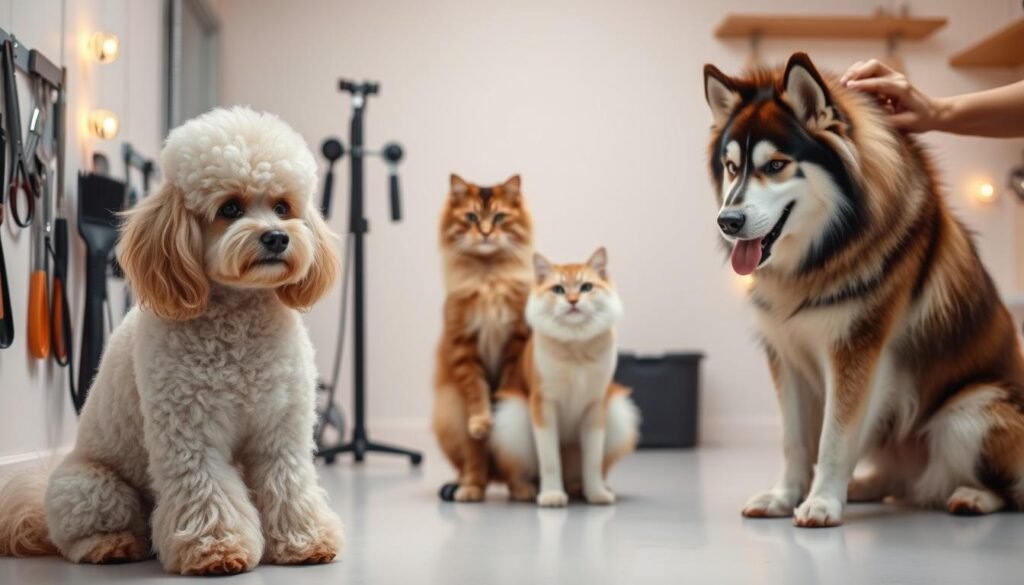
To summarize the grooming needs of different breeds, the following table provides a quick reference guide:
| Breed Type | Grooming Frequency | Special Needs |
|---|---|---|
| Long-Haired Dogs | Daily brushing, bathing every 4-6 weeks | Regular inspection for skin issues, matting |
| Short-Haired Dogs | Bathing every 2-3 months, regular nail trimming | Ear cleaning, occasional brushing |
| Long-Haired Cats | Daily brushing, regular nail trimming | Preventing hairballs, matting |
| Short-Haired Cats | Occasional brushing, regular nail trimming | Reducing shedding, distributing skin oils |
By understanding and catering to the breed-specific grooming needs of your pet, you can enhance their comfort, health, and overall well-being.
Grooming for Senior Pets
The grooming requirements for senior pets differ from those of younger animals, necessitating adjustments in technique and approach to ensure their comfort and health.
Adjusting Techniques for Older Pets
As pets age, their physical condition and health status can significantly impact their grooming needs. For instance, older pets may have reduced mobility, making it essential to be gentle and patient during grooming sessions.
- Be gentle and patient, as older pets may have sensitive areas.
- Use grooming tools that are designed for comfort and ease of use.
- Consider shorter grooming sessions to avoid fatigue.
Special Health Considerations
Senior pets often have specific health issues that need to be considered during grooming, such as arthritis, skin conditions, or dental problems.
Key health considerations include:
- Monitoring for signs of pain or discomfort during grooming.
- Being aware of any health conditions that may affect grooming, such as skin allergies.
- Adjusting grooming techniques to accommodate physical limitations.
Comforting Your Senior Pet During Grooming
Making grooming a comfortable and enjoyable experience is crucial for senior pets. This can be achieved by creating a calm environment and using positive reinforcement techniques.
Tips for comforting your senior pet include:
- Using a calm, gentle voice to reassure your pet.
- Providing treats and praise during grooming sessions.
- Ensuring the grooming area is quiet and free from distractions.
By adjusting grooming techniques and being mindful of the special needs of senior pets, you can help ensure their grooming experience is both comfortable and beneficial.
Addressing Common Grooming Challenges
The grooming process can be stressful for both pets and their owners, particularly when dealing with anxious animals or tangled fur. Many dogs can experience stress or anxiety during grooming due to their unfamiliarity with the process or specific tools being used.
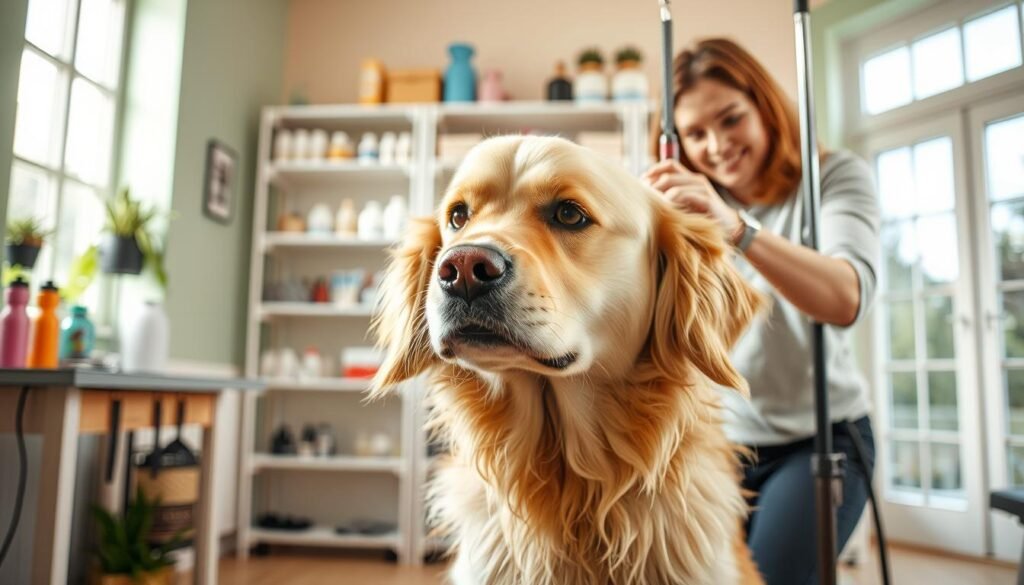
Dealing with Fearful Pets
Fearful pets require a gentle and patient approach to grooming. It’s essential to introduce grooming tools gradually, allowing your pet to become comfortable with their presence and use.
- Start with short sessions to avoid overwhelming your pet.
- Use positive reinforcement techniques, such as treats and praise, to create a positive association with grooming.
- Be gentle and calm, as pets can sense their owner’s anxiety.
Managing Matting and Tangles
Matting and tangling are common issues, especially in long-haired breeds. Regular brushing is key to preventing these problems.
| Tool | Purpose | Best For |
|---|---|---|
| Slicker Brush | Removes tangles and mats | Long-haired breeds |
| Pin Brush | Gentle detangling | Short to medium-haired breeds |
| Detangling Spray | Eases brushing process | All breeds with tangled fur |
Handling Allergies and Sensitivities
Some pets may have allergies or sensitivities to certain grooming products. It’s crucial to identify these issues early.
Signs of allergy or sensitivity: Redness, itching, or irritation after grooming.
If you notice any of these signs, consult with your veterinarian to determine the best course of action and to find suitable grooming products.
Grooming is an essential part of pet care, and addressing common challenges can make the process more enjoyable for both you and your pet.
The Role of Grooming in Pet Health
Maintaining a regular grooming routine can significantly enhance pet health and detect potential issues early. Grooming is not just about keeping your pet looking their best; it’s a crucial aspect of their overall health care.
Skin Health Awareness
Regular grooming helps in monitoring and maintaining skin health. Through grooming, pet owners can identify issues such as dryness, irritation, or infections early on. Proper brushing and bathing techniques can prevent matting and reduce the risk of skin problems.
Grooming allows for the distribution of natural oils across the skin, promoting healthy skin and a shiny coat. It also provides an opportunity to inspect for any abnormalities, such as lumps or lesions, which could be indicative of underlying health issues.
Ear and Eye Care
Ear and eye care are critical components of the grooming process. Cleaning the ears regularly can prevent wax buildup and reduce the risk of infections. Similarly, gently cleaning around the eyes can help prevent tear stains and detect any eye issues early.
Regular inspection during grooming sessions can help identify signs of infection or irritation in these sensitive areas, allowing for prompt veterinary care if necessary.
Preventing Parasites through Grooming
Grooming plays a significant role in preventing parasite infestations. Regularly inspecting your pet’s coat and skin during grooming can help detect fleas, ticks, and other parasites early. Using the right grooming tools and techniques can aid in removing these unwanted guests.
| Grooming Activity | Health Benefit |
|---|---|
| Brushing | Distributes natural oils, prevents matting |
| Bathing | Cleans the coat, reduces risk of skin infections |
| Nail Trimming | Prevents overgrowth, reduces risk of injury |
| Ear and Eye Cleaning | Prevents infections, detects issues early |
By incorporating regular grooming into your pet care routine, you can significantly contribute to their overall health and wellbeing. It’s a simple yet effective way to ensure your pet remains healthy and happy.
Grooming as a Bonding Experience
The act of grooming can be a powerful bonding experience, fostering a deeper connection between pets and their owners. Regular grooming sessions provide an opportunity to spend quality time together, enhancing the emotional bond and trust.
Making Grooming Enjoyable for Your Pet
To make grooming a positive experience, it’s essential to start slowly and be gentle. Begin with short sessions and gradually increase the duration as your pet becomes more comfortable. Using the right tools and techniques can also make a significant difference. For instance, using a brush that is suitable for your pet’s fur type can make the experience more enjoyable.
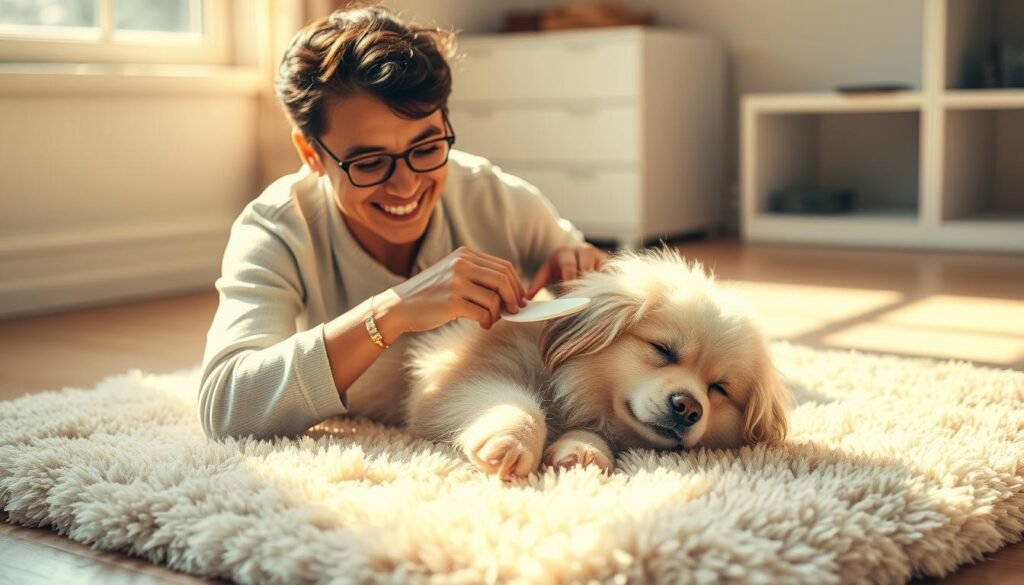
Creating a Calm Environment
A calm environment is crucial for a successful grooming experience. Ensure the space is quiet, comfortable, and free from distractions. You can also play soothing music to help your pet relax. It’s also important to be calm and patient, as pets can sense their owner’s stress and anxiety.
Engaging in Positive Reinforcement
Positive reinforcement is a powerful tool during grooming. Reward your pet with treats, praise, and affection when they exhibit calm behavior. This encourages them to associate grooming with positive experiences, making future sessions easier and more enjoyable.
| Tips for a Positive Grooming Experience | Benefits |
|---|---|
| Start with short sessions | Reduces stress and anxiety |
| Use appropriate grooming tools | Makes grooming more comfortable |
| Create a calm environment | Enhances relaxation and trust |
| Use positive reinforcement | Encourages positive association with grooming |
By following these tips and making grooming a positive experience, you can strengthen the bond between you and your pet. Regular grooming not only improves your pet’s physical health but also enhances your emotional connection, creating a more loving and trusting relationship.
Seasonal Grooming Tips
Different seasons bring unique challenges for pet grooming, from matting in winter to sun protection in summer. As a responsible pet owner, it’s crucial to adjust your grooming routine to meet your pet’s changing needs throughout the year.
Summer and Winter Grooming Needs
In the summer, pets need extra care to stay cool and protected from the sun. Regular brushing can help remove loose fur, reducing the risk of matting and tangling. For pets that spend a lot of time outdoors, consider using a pet-safe sunscreen to protect their skin from harmful UV rays.
Winter brings its own set of challenges, such as dry skin and matting caused by thick coats. Regular grooming during this season can help prevent these issues. Use a moisturizing shampoo and conditioner to keep your pet’s skin hydrated and healthy.
Preparing for Seasonal Allergies
Seasonal allergies can affect pets just like humans. Regular grooming can help reduce the amount of allergens on your pet’s coat. Bathe your pet regularly using a hypoallergenic shampoo to minimize irritation. Additionally, consider using an anti-allergen spray to further protect your pet’s skin.
Protecting Your Pet from Extreme Weather
Extreme weather conditions, such as intense heat or cold, can be harmful to pets. In the summer, provide plenty of shade and water to keep your pet cool. In the winter, consider using a pet coat or sweater to keep them warm during outdoor walks.
By adjusting your grooming routine according to the season and taking steps to protect your pet from extreme weather, you can help ensure their comfort and health year-round.
Conclusion: Groom with Love and Care
Grooming is an essential aspect of Pet Care that not only enhances your pet’s appearance but also contributes to their overall health and well-being. By understanding the importance of Pet Grooming and implementing the right Grooming Tips, you can strengthen your bond with your pet and ensure they lead a happy, healthy life.
Key Takeaways
Throughout this article, we’ve explored various facets of pet grooming, from essential grooming tools to breed-specific needs and seasonal considerations. With practice and patience, pet owners can become proficient in grooming their pets, making it a rewarding experience for both the pet and the owner.
Start Grooming Today
Embracing Pet Grooming as a regular practice can significantly improve your pet’s quality of life. By applying the Grooming Tips discussed, you can help prevent health issues, reduce stress, and enhance your pet’s overall comfort and happiness.
Final Tips
Remember, the key to successful pet grooming is patience, love, and care. Be gentle, consistent, and attentive to your pet’s needs, and you’ll find that grooming becomes a positive experience for both of you. By incorporating Pet Care and grooming into your daily routine, you’ll not only be improving your pet’s health but also deepening your relationship with them.
FAQ
What is pet grooming, and why is it essential for my pet’s health?
How often should I groom my pet, and what factors influence this frequency?
What are the essential tools I need for grooming my pet at home?
Can I groom my pet at home, or should I use professional pet grooming services?
How can I make grooming a positive experience for my pet?
What are some common grooming challenges, and how can I overcome them?
How does grooming contribute to my pet’s overall health?
Are there any seasonal grooming tips I should be aware of?
What should I look for when choosing a professional groomer for my pet?
How can I groom my senior pet comfortably and safely?
Prabir Dutta
Prabir Dutta is a passionate digital creator, affiliate marketer, and wellness enthusiast who simplifies complex topics like AI tools, Vastu, pet care, and modern living. With a keen eye for SEO, tech trends, and everyday health solutions, he writes to empower readers with actionable, smart-living insights. When not curating content across his network of niche blogs, Prabir enjoys exploring new digital tools that make life easier and more efficient.

